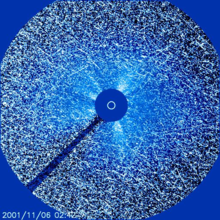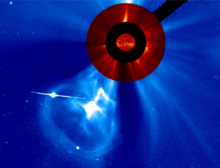news
Submitted on 2014-02-14
What seemed to be a boring and declining sunspot group suddenly turned out to be the most flare productive group of the week.
On 9 February, NOAA 1974 was a relatively small group with almost no spots in its trailing end. Then, in the course of the day, new magnetic flux emerged in this trailing portion gradually increasing its sunspot area to nearly 6 times the surface area of the Earth by 15 February. In view of the close proximity of the sunspot groups (less than 10 degrees in heliographic longitude), this region was still considered as 1 sunspot group.
Submitted on 2014-02-13
NOAA 1967 has rotated behind the west limb. It was a little bit of a disappointment that the largest sunspot group so far this solar cycle (according to NOAA statistics), only produced numerous M-flares. The approximate positions of 15 of these M-flares, produced between 30 January and 7 February, are indicated on a 2 February SDO-image of NOAA 1967.

Submitted on 2014-02-06
On 27 January, a big, complex region rounded the Sun's east limb and was labelled NOAA 1967. This large sunspot group was the return of NOAA 1944 which appeared early January and was very active at that time, including 7 M- and 1 X-class flare. Using solar eclipse glasses, both groups were easy naked-eye objects.

Submitted on 2014-01-16
Without a doubt, the big and complex sunspot group NOAA 1944 was the talk of the week. During its transit over the solar disk (1-14 January), it produced 1 X- and 7 M-class solar flares. Here we will deal with some of the more enigmatic aspects of the group's size and the X-class flare it produced.
1. Was NOAA 1944 the largest sunspot group so far this solar cycle?
Submitted on 2014-01-09
This promising letter arrived at the STCE’s Public Outreach Office on 1 January. It reads:

The Sun apparently wants to keep its New Year's resolutions. Indeed, on the very first day of the year it produced a great prominence eruption, a very strong solar flare, and one of the largest sunspot groups so far this solar cycle. This can be seen in this movie.
Submitted on 2014-01-02
During 2013, long stretches of solar inactivity alternated with brief spurts of high flaring activity levels. The periods of solar calm featured numerous filament and prominence eruptions, with so many spectacular events they could easily fill this review. There were 12 X-class solar flares, almost as many as 2011 and 2012 combined. Yet, only 5 sunspot regions were responsible for these extreme explosions on the Sun, and most of them took place during the latter part of 2013.
Submitted on 2013-12-19
On December 8 and 13, something particularly interesting happened in the solar wind: ACE in situ solar wind data showed a shock and both times the shock was driven by a coronal hole. Shocks driven by a coronal mass ejection are common. But this was shocking news.
Fast catches up with slow
Submitted on 2013-12-13This news item was created by the P2SC-team and is available here.
Pages
Zircon - This is a contributing Drupal Theme
Design by
WeebPal.


















